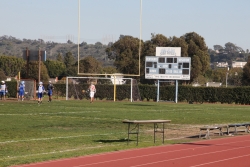Culver City voters may soon have the opportunity to decide if they are willing to tax themselves again in the name if public education.
Culver City Unified School District Board of Education President Katherine Paspalis has indicated that she favors a bond proposal to fund the district’s capital improvements plan for Culver City High School, the Robert Frost Auditorium and the repair of other school district buildings.
A plurality of Culver City voters approved a sales tax, Measure Y, on Nov. 6. The municipal sales tax will be raised one-half cent over a 10 year-period.
City leaders depicted the tax as a necessary move in order to stave off potentially devastating in services and employee positions.
In 2009, voters passed Measure EE, a parcel tax measure that added $96 to the property rolls in Culver City in 2009. The parcel levy raised $1.2 million dollars to help offset potential reductions in programs and personnel at the school district.
The principal architect of Measure EE, Scott Zeidman, is supportive of the idea of a bond measure for the capital improvements plan.
“The possibility of upgrading facilities in the district, including the football field, are of the utmost importance, not only to the school district but also to the community,” said Zeidman, a former CCUSD president and a graduate of Culver City High.
“This is the right thing to do at the right time.”
Paspalis said the funds at the district’s disposal are not sufficient in order to complete the projects. “We’re sorts of fighting over crumbs,” she said.
If a bond measure is proposed and eventually passed, it will make the third time in five years that Culver City has asked its citizens to tax themselves. Additionally, supporters of Measure EE could seek to revisit the parcel tax initiative again.
Tom Supple, a 30-year Culver City resident, thinks those who favor passing a bond might have more trouble succeeding than they think. “It’s hard to believe that they would be asking for more money again,” said Supple. ‘It seems like every time we have an election, someone is asking for more money.
“It seems like with the sales tax and Measure EE, no matter how much we give them, they always want more.”
In the mid 1990s, Culver City voters passed Measure T, a bond measure that also was targeted for capital improvements. The message then was similar to this year’s reasoning: the school district’s infrastructure is in need of an upgrade.
Paspalis said schools like El Marino Language School, which her two children attended, is approximately 60 years old. “People need to realize that if schools are in good shape, that translates into higher property values,” she argued.
Board member Nancy Goldberg said she is undecided on whether a bond measure is the right move for the school district. She said she would need to study such a proposal in greater details.
Papalis said the district would engage the public on the merits of a bond measure. “We have a sense of what the athletic field costs as well as the costs for the Robert Frost Auditorium and the natatorium,” she said.
The board president said the football field will cost an estimated $13-15 million in renovations.
Some cities in recent times have become more resistant to absorbing taxes, even if it is for public benefit.
In Los Angeles, Councilman Mitchell Englander was rebuffed in his attempt earlier this month when he floated the idea of a bond measure to pay for much needed infrastructure enhancements.
Supple thinks Culver City’s elected leaders, whether they are school board members or members of the city council, could soon exasperate voters who in recent years have supported local and statewide tax measures.
“It’s going to reach a breaking point, eventually,” he predicted.













